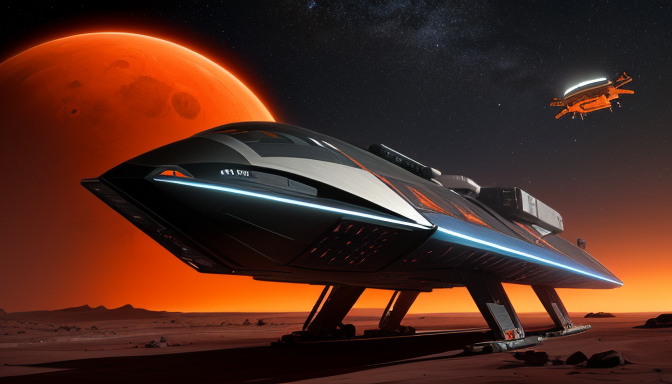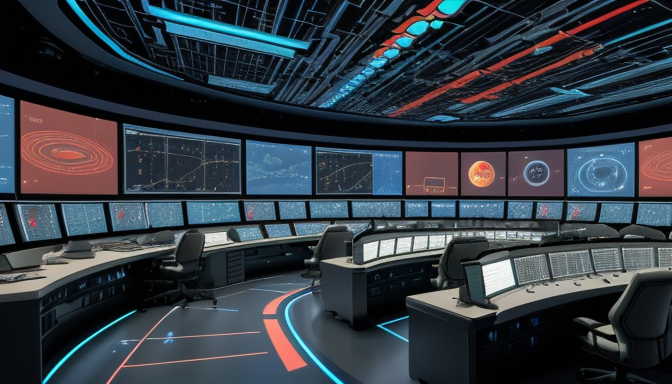Imagine standing on the rusty, red soil of Mars, gazing up at a sky filled with distant stars, and feeling the thrill of being a pioneer on another planet. Sounds like a scene straight out of a sci-fi movie, right? But as technology leaps forward, the question arises: is this breathtaking vision of traveling to Mars merely a dream, or is it on the brink of becoming a reality? With every passing year, advancements in space travel technology bring us closer to the possibility of human colonization of the Red Planet.
As we delve into the current state of space exploration, we see a dynamic landscape where both government agencies and private enterprises are investing heavily in space travel. NASA, for instance, is ramping up its efforts through the Artemis program, which aims to return humans to the Moon as a stepping stone for Mars missions. Meanwhile, private companies like SpaceX are developing innovative spacecraft that could revolutionize interplanetary travel. These initiatives are not just ambitious; they are paving the way for what could be the most significant human endeavor since the Moon landing.
However, the journey to Mars is not without its challenges. From the harsh environmental conditions on the planet to the psychological toll of long-term space travel, there are numerous hurdles that must be overcome. Yet, the spirit of exploration drives humanity forward. The collaboration between nations and private companies is crucial; working together could accelerate our timeline for reaching Mars. So, as we look to the future, we can’t help but wonder: will we see humans set foot on Mars within our lifetime? The answer might just be a resounding yes.
The Current State of Space Travel
Space travel is no longer the stuff of science fiction; it has evolved into a thrilling reality that captivates our imagination. With advancements in technology and a surge of interest from both governmental agencies and private companies, we are on the brink of a new era in space exploration. The recent launches by SpaceX, NASA, and other organizations are paving the way for potential missions to Mars, making the idea of colonizing the Red Planet seem less like a distant dream and more like an achievable goal.
Take, for example, SpaceX’s Starship, which is designed for interplanetary travel. This spacecraft is not just a marvel of engineering; it represents a significant leap forward in our capabilities. It’s built to carry humans and cargo to destinations beyond Earth, including Mars. NASA’s Artemis program is another exciting initiative, aiming to return humans to the Moon and use it as a stepping stone for future Mars missions. These programs showcase a commitment to exploring our solar system like never before.
Moreover, the collaboration between nations is becoming increasingly vital. Countries like China, India, and the United Arab Emirates are ramping up their space programs, contributing to a global effort in space exploration. This international collaboration is essential, as it fosters knowledge sharing and resource pooling, allowing for more ambitious projects.
In summary, the current state of space travel is characterized by rapid advancements and collaborative efforts that promise to transform our understanding of the universe. With every launch and mission, we inch closer to making human life on Mars a reality. The question is, are we ready to take that leap?

Technological Innovations for Mars Travel
When we think about traveling to Mars, it feels like we’re stepping into the pages of a sci-fi novel. But guess what? The reality is that technological innovations are rapidly transforming this dream into a possible future. Companies like SpaceX and NASA are at the forefront, developing groundbreaking technologies that could make human travel to the Red Planet a reality.
One of the most exciting advancements is in spacecraft design. The Starship, for instance, is being engineered not just for interplanetary travel but for reusability, which is a game changer. Imagine a vehicle that can launch, land, and then be used again for multiple missions! This could drastically reduce the costs associated with space travel, making it more accessible.
Then there’s the propulsion systems. Traditional rocket engines may soon be joined by nuclear thermal propulsion and ion propulsion technologies. These systems promise to cut travel time to Mars significantly—imagine reducing a six-month journey to just a few weeks! This is not just about speed; it’s about ensuring the safety and well-being of astronauts during their long voyage.
Life support systems are also undergoing a revolution. Engineers are working on sustainable systems that can recycle air and water, which is crucial for long-term missions. After all, what good is a spacecraft if it can’t keep its crew alive? These innovations not only enhance safety but also pave the way for potential colonization, as they can support human life in Martian conditions.
In summary, the technological innovations for Mars travel are not just exciting; they are essential. With each breakthrough, we are one step closer to making the dream of colonizing Mars a tangible reality. So, are we ready to pack our bags for the Red Planet? Only time will tell!
Challenges of Mars Colonization
When we think about colonizing Mars, it’s easy to get caught up in the excitement of the adventure. However, we must also face the harsh realities that come with it. Mars is a beautiful yet unforgiving planet, and establishing a human presence there is no walk in the park. First off, the environmental conditions on Mars are incredibly challenging. With temperatures dropping to a bone-chilling -80 degrees Fahrenheit at night and dust storms that can cover the entire planet, it’s like trying to survive in an extreme desert.
Another major hurdle is radiation exposure. Unlike Earth, which is protected by a thick atmosphere and magnetic field, Mars is bombarded by cosmic rays and solar radiation. This can lead to serious health risks for astronauts, including increased chances of cancer and other illnesses. To tackle this, scientists are exploring innovative solutions, such as building habitats underground or using Martian soil to create protective walls.
But wait, there’s more! The psychological effects of long-term space travel cannot be overlooked. Imagine being cooped up in a spaceship with the same people for months on end, with no escape. The mental strain could be overwhelming. To combat this, future missions will need to incorporate recreational activities and mental health support to keep astronauts from going stir-crazy.
In summary, while the dream of colonizing Mars is thrilling, we must confront these significant challenges head-on. The journey will require not just technological advancements, but also a deep understanding of human resilience and adaptability. As we push forward, let’s remember that every challenge is an opportunity for innovation, paving the way for a brighter future among the stars.

International Collaboration in Space Exploration
When it comes to exploring the vastness of space, teamwork makes the dream work. The journey to Mars is not just a job for one nation; it’s a global endeavor that requires collaboration among various countries and private sectors. Think of it as a giant puzzle where each piece represents a different nation’s expertise, technology, and resources. By working together, we can solve the mysteries of the universe, and Mars is the next big frontier!
Countries like the United States, Russia, China, and members of the European Space Agency are already sharing knowledge and resources to push the boundaries of space exploration. For instance, NASA’s Artemis program aims to return humans to the Moon and eventually set the stage for Mars missions, involving partnerships with international space agencies. This collaboration not only enhances technological capabilities but also reduces costs significantly. After all, why reinvent the wheel when you can share the ride?
Moreover, private companies like SpaceX, Blue Origin, and others are stepping into the arena, bringing innovative approaches and fresh ideas. Their involvement adds another layer to this international tapestry of cooperation. A prime example is SpaceX’s collaboration with NASA to develop the Starship, which is designed for missions to Mars. By pooling resources and expertise, these partnerships can accelerate timelines and improve safety protocols, making the dream of colonizing Mars more attainable.
However, it’s not just about technology; it’s about building trust and fostering relationships. Space exploration can serve as a bridge for diplomacy, helping nations work together towards a common goal. As we look to the stars, we must remember that the future of humanity in space relies on our ability to collaborate and innovate together. In this grand adventure, every small step taken by nations collectively is a giant leap for mankind.
The Future of Mars Exploration
As we gaze into the cosmos, the future of Mars exploration is not just a flickering dream; it’s a vivid reality taking shape before our very eyes. With ambitious plans laid out by both governmental space agencies like NASA and private companies such as SpaceX, the timeline for crewed missions to the Red Planet is becoming increasingly tangible. Imagine standing on the Martian soil, looking back at Earth, and realizing that humanity has made a monumental leap into the cosmos!
So, what does this future entail? First and foremost, we can expect crewed landings on Mars within the next decade. NASA aims for a manned mission by the late 2030s, while Elon Musk has set his sights on sending humans to Mars as early as 2026! These timelines might seem ambitious, but with the rapid advancements in technology, they are not out of reach.
Furthermore, robotics will play a crucial role in paving the way for human settlers. Before astronauts set foot on Mars, unmanned missions will scout the terrain, gather data, and even begin constructing habitats. These robots will act as our eyes and hands, preparing for the arrival of humans and ensuring that the environment is safe for habitation.
Long-term, the vision for Mars is even more exciting. Plans for sustainable living, including greenhouses for food production and systems for recycling air and water, are already in the works. The ultimate goal? To create a self-sustaining colony where humans can thrive, turning Mars from a barren wasteland into a bustling hub of exploration and discovery.
In conclusion, the future of Mars exploration is a thrilling mix of innovation and collaboration. As we continue to push the boundaries of what’s possible, who knows what incredible discoveries await us on the Red Planet? The journey is just beginning, and the cosmos is calling!
Frequently Asked Questions
- Is traveling to Mars possible in our lifetime?
Absolutely! With advancements in technology and ongoing missions by both government and private sectors, many experts believe that crewed missions to Mars could happen within the next couple of decades. It’s like watching a rocket take off; it feels impossible until it’s soaring through the sky!
- What are the main challenges of colonizing Mars?
Colonizing Mars isn’t just about landing there; it involves tackling harsh environmental conditions, exposure to radiation, and psychological impacts of long-term space travel. Think of it like camping in the most extreme weather—there’s a lot to prepare for!
- How are international collaborations helping Mars exploration?
International collaborations bring together resources, expertise, and technology from various countries, making missions more feasible and efficient. It’s like a global team working together to build a spaceship; everyone has a unique skill that contributes to the success of the mission!
- What technologies are being developed for Mars travel?
Innovations in spacecraft design, propulsion systems, and life support technologies are at the forefront of making Mars travel safer and more efficient. Imagine creating a high-tech vehicle that not only takes you to another planet but also keeps you alive during the journey!
- When can we expect the first crewed mission to Mars?
While exact timelines can vary, many organizations are aiming for the 2030s for the first crewed missions. It’s like waiting for a new blockbuster movie; the anticipation builds as we get closer to the premiere!

